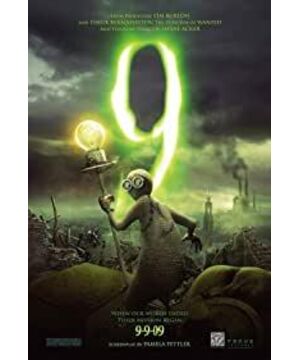Robots and roles correspond to typical personality characteristics of 12 constellations Correspondence to personality type
9 No. 1 veteran Scorpio Leo authority fear [Perfect] Type
1 Inventor No. 2 Aquarius Libra Practical commitment [Giver] 2 Type
3 Bookkeeper Gemini _____ Curious and rational [Observer] Type
5 Bookkeeper No. 4 Virgo _____ Intellectual experience [Doubt] Type
6 No. 5 Mechanic Masterpiece _____ Practical implementation [Doer] 3 Type
6 Artist Cancer Pisces Fantasy Intuition [Romantic] Type
4 Female Warrior Aries _____ Heroic Fighting [Protector] Type
8 Hercules Taurus _____ Power Enjoyment [Enjoyer] Type
7 Explorer Sagittarius No. 9 _____ Spiritual fraternity [Mediator] Nine-type
No. 1 died of fear and self-acceptance, No. 2 died of an innocent sacrifice, No. 5 died in a resurrection raid after blasting, No. 6 died of compassion for the martyrs, No. 8 Died by magnets for self-enjoyment. Those who die are all negative constellations, and finally turn into the seeds of new life.
The last alive Gemini, Virgo, Aries, and Sagittarius are all positive signs. They are observer and doubter (scientific spirit), protector and mediator (humanistic spirit).
2. Enneagram and Kabbalah System and Origin Enneagram and Kabbalah Enneagram
originated in Babylon in 2500 BC, one of the Sufi sects of Islam, and is present in Turkey, Syria, Afghanistan and other places in the Middle East. George Gurdjieff was introduced to the West in 1900, and Oscar Ichazo introduced intelligence from Afghanistan in 1950 and established the research institution Erica Academy. Post-psychologists Claudio Naranjo, Don Riso and Russ Hudson elaborated on it, the system is as follows:
The first type: the perfect type (Reformer / Perfectionist) [reformers] perfectionist
patience, reflection, law-abiding, leader, anger, frustration, orderly
second type: Full of love type, helping type (Helper / Giver) to give [ Those who are
gentle, friendly, sacrificed, giving , proud, controlling, and loving Angels
Type 3: Achiever/Motivator [Practicers]
Work, eager, smooth, ambitious, narcissistic, rigid, and the pursuit of success
Type 4: Artist/Individualist (Artist/Individualist) [Sad Romance]
Self, melancholy, fantasy, emotion, jealousy, self-pity, and unique temperament
Type 5: Intelligence, Thought (Thinker/Observer) [Observer]
Spirit, Refined, organized, introverted, alienated, sensible, and knowledgeable
Type 6: Loyalty (Team Player/Loyalist) [Sceptic]
Cautious, pragmatic, observant, loyal, cowardly, hesitant, diligent and cautious
Type 7: Active type Enthusiast [Hedonist]
Entertaining, enjoying, enthusiastic, rude, impulsive, addicted, entertaining others.
Type 8: Leader, Capable (Leader) [Protector]
Justice, independence, action, Positive, challenging, subjective, indomitable
type 9: Peaceful, harmonious (Peacemaker) [Mediator]
Easy-going, indifferent, individuality, laziness, carelessness, sleepwalking, peaceful and indifferent
Similar to the graphic and classification analysis methods of Enneagrams, there are also the "Kabbalah" Kabbalah that originated from the Judaism "Pentateuch", "Missina" and "Talmud", such as Abelah in 2000 BC The Book of Creation by Rare Sefer Yetzira, Zohar's Light in the 2nd century AD, Seven Deadly Sins in the early 4th century AD, Seven Deadly Sins in the early 4th century AD, Ari's Tree of Life in the 16th century AD, Yehuda in the 20th century AD Ashlag (Baal Sulam)'s "A Study of Ten Sefirot" and so on.
Similarly, in China, there are the interpretations of the Eight Trigrams of Fuxi Painting in 3000 BC, the Sixty-Four Trigrams of Zhou Wenwang, and the interpretation of the Sixty-Four Trigrams of Confucius in 500 BC.
3. Origin of Constellation and Astrology
In 1000 BC, Babylon and Sumer proposed 30 constellations, which were later spread to Egypt and Greece. In 270 BC, the word constellation was mentioned in the poem Phaenomena written by the Greek poet Aratus. In 150 AD, the Greek scientist Tolemy Ptolemy wrote Amagest, which listed 48 constellations and the names of 1022 stars. Magellan also studied the constellations during his circumnavigation in the 16th century. In 1928, the International Astronomical Union officially announced the names of 88 constellations. Following the historical title, the 88 constellations are divided into 3 sky regions, 29 in the northern hemisphere, 47 in the southern hemisphere, and 12 near the ecliptic.
China has divided the sky into three walls and twenty-eight nights a long time ago. The "Historical Records·Book of Heavenly Officials" records quite detailed. Sanyuan is the three areas around the North Tianji, namely Ziweiyuan, Taiweiyuan, and Tianshiyuan. Twenty-eight places are located in the 28 areas near the ecliptic and white paths, namely, the seven places in the east: horn, kang, di, fang, heart, tail, and Ji.
In 2000 BC, the Sumerians built seven-level temples in Ur and Uruk, each level representing a celestial body: Moon, Sun, Mercury, Venus, Mars, Jupiter and Saturn. In 2778 BC, Ancient Egypt gave birth to the most accurate calendar and observed the connection between Sirius and the flooding of the Nile. The pyramids and Stonehenge in England in 2200 BC also have astrological significance.
From the 18th century BC to the 16th century BC, the first books on astrology appeared in Babylon. From the 6th century BC to the 4th century BC, astrology was introduced to Egypt, Greece, the Near East and India, and then to Central Asia through the Indian monks. After the 3rd century BC, the concept of the universe and man was mathematicalized, and its theoretical system was finalized after the 1st century AD. Ancient Greek astrology (astrologia) and astronomy (astronomia) did not clearly decompose. They used Babylonian planet names, but took the sun as the main star, and mainly studied the twelve constellations of the zodiac, and gave them mythological connotations. Greek astrology has an influence on alchemy, Manichaeism and Christianity.
In 1609, the Italian Galileo Galilei invented the telescope. In 1611, the German astronomer Kepler J. Kepler developed an astronomical telescope and discovered the laws of planetary movement. He also became the founder of modern astrology. Since then, astronomy and astrology have diverged. In July 2000, Kepler College in Seattle brought astrology back to university. Its courses included history, philosophy, cultural anthropology, mythology, comparative religion, psychology, astronomy, mathematics, logic, statistics, and ethics. , System theory, literature, etc.
During the Northern Song Dynasty in China, Taoist Chen Tuan (Chen Xiyi) invented the Ziwei Doushu, which was formerly known as the "Eighteen Flying Stars". Doushu came into being a little later than the five-star technique, and about the same time as the Ziping technique (eight characters, four pillars), it was influenced by Indian astrology. His important documents include "The Complete Works of Doushu" and "The Complete Works of Doushu" about 200 years ago, "Taiwei Fu", "Bone Marrow Fu", etc., Lu Binzhao's "Ziwei Doushu Lectures" during the Republic of China, and the opened book Ziwei Doushu and Wang Tingzhi's "Zhongzhou School Ziwei Doushu" in the 1990s. Xiandoushu is divided into two main mainstreams: one is based on the interpretation of Xing Yao, collectively referred to as the Sanhe School; the other is based on the interpretation of the Four Modernizations, collectively referred to as the Sihua School.
View more about 9 reviews











